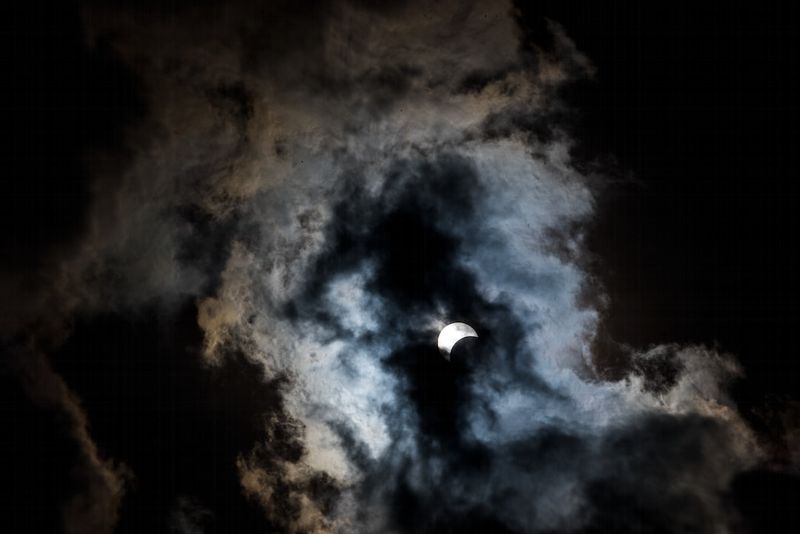Saturday’s Annular Solar Eclipse: A Celestial Phenomenon Unveiled
On Saturday, October 14, skywatchers across the Americas will have the opportunity to witness a rare celestial spectacle: an annular solar eclipse. As the moon aligns with the sun, a blazing ring of fire will appear in the sky, captivating viewers from Oregon to Brazil. This article aims to decode the mysteries of this astronomical event by exploring its five main stages and providing advice on safe viewing practices.
The Three Major Types of Eclipses
To understand the significance of the annular solar eclipse, it is crucial to differentiate between the three major types of eclipses. A total solar eclipse occurs when the moon completely blocks the face of the sun, casting a temporary darkness upon the Earth. In contrast, an annular solar eclipse happens when the moon is further from Earth and only obscures part of the solar disk. Lastly, a partial solar eclipse occurs when the Earth, moon, and sun are not perfectly aligned, causing the moon to cover only a portion of the sun.
The Five Stages of the Annular Solar Eclipse
The annular solar eclipse on October 14 will unfold in five distinct stages, each offering a unique spectacle for skywatchers:
Stage 1: First Contact
During the first stage, which marks the beginning of the eclipse, the moon will gradually pass in front of the sun, initiating a partial solar eclipse. As this occurs, the dark disk of the moon will create the illusion of a progressively larger bite out of the sun’s illuminated face.
Stage 2: Second Contact
Approximately one hour and twenty minutes after the first contact, the annular eclipse, or annularity, begins. At this point, the moon has fully positioned itself in front of the sun, causing sunlight to form a mesmerizing “ring of fire” around the moon. A fascinating phenomenon known as “Baily’s Beads” may also be observed during this stage. These droplets of light, shaped like droplets of water, appear in an arc around the moon’s edge. They are created by the uneven terrain of the moon, which allows sunlight to stream through gaps between mountains and valleys.
Stage 3: Maximum Eclipse
During this stage, the moon completely covers the center of the sun’s disk, resulting in the appearance of a glowing ring of fire. The duration of annularity varies depending on the location along the eclipse’s path, typically lasting between four and five minutes. For instance, viewers at Oregon Dunes in Oregon will witness the ring of fire for approximately four minutes and twenty-nine seconds, while those in Corpus Christi, Texas, will enjoy the spectacle for around four minutes and fifty-two seconds.
Stage 4: Third Contact
As the moon gradually moves away from the sun’s disk, the annularity ends, and the second partial eclipse period commences. Skywatchers will once again have the opportunity to witness the mesmerizing Baily’s Beads along the edge of the moon.
Stage 5: Fourth Contact
In the final stage, the moon completely disengages from the sun, no longer partially eclipsing it, thereby concluding the annular eclipse of 2023.
Safety Precautions for Eclipse Viewing
While witnessing the annular solar eclipse is undoubtedly an awe-inspiring experience, it is essential to prioritize safety when observing such events. Directly looking at the sun without adequate protection can cause irreversible damage to the eyes. Therefore, it is crucial to take precautions, such as wearing specialized eclipse glasses made from safe solar filter materials. Regular sunglasses, no matter how dark, cannot fully protect the eyes from the harmful effects of the sun.
Telescope observers should also utilize special filters to ensure a safe viewing experience. One simple method for viewing the annular eclipse without risking eye damage is to project the image of the sun onto a sheet of card. This can be achieved by poking a small hole in a card using a pencil point and positioning it towards the sun. Another card should be held a few feet behind the first one to capture the projected image of the sun.
Editorial: The Beauty and Mystery of Celestial Phenomena
The annular solar eclipse serves as a reminder of the wonders of the universe that exist beyond our immediate comprehension. These moments of celestial alignment invite us to ponder our place in the vastness of space and the interconnectedness of all things. As we gather to witness this rare spectacle, we should take the opportunity to reflect on the awe-inspiring nature of our universe and the beauty that lies within it.
Such celestial events also highlight the significance of scientific research and exploration. They underscore the importance of further understanding the mysteries of our universe, deepening our knowledge of the cosmos, and inspiring future generations of scientists and astronomers.
Conclusion
The annular solar eclipse of October 14, 2023, promises to be a captivating event for observers across the Americas. By understanding its five main stages and adhering to safety precautions, skywatchers can safely witness the mesmerizing ring of fire in the sky. As we gaze upon this celestial phenomenon, let us remember the profound mysteries that lie beyond our planetary boundaries and the power of scientific exploration to unveil the enigmas of our universe.

<< photo by Bank Phrom >>
The image is for illustrative purposes only and does not depict the actual situation.
You might want to read !
- Breaking Down the Spectacular Sights: A Guide to Viewing the 2023 ‘Ring of Fire’ Solar Eclipse
- A Celestial Spectacle: Guiding You on Witnessing the Mesmerizing “Ring of Fire” Annular Solar Eclipse in 2023
- 5 Things to Understand About the Upcoming “Ring of Fire” Solar Eclipse
- The Allure of Lenny Kravitz: Exploring Sensuality and Artistry in His Steamy Music Video
- “Analyzing the Implications of Reduced Social Security Increases for Senior Citizens in 2024”
- “Unleashing Gridiron Glory: Analyzing the Houston vs. West Virginia Matchup in the 2023 College Football Season”
- Colorado Governor Polis Takes a Stand Against Antisemitism with Proclamation
- “The Future of Chicago’s Lincoln, Irving, and Damen Crossing: A Vision for Connectivity and Mobility”
- “Ring of Fire Eclipse: A Celestial Spectacle to Illuminate Our Skies”
- The Rise of Victor Wembanyama: NBA’s Newest Sensation Leaps and Blocks His Way to Stardom
- Opinion: Analyzing the Impact of Pro-Palestine Demonstrations on Manhattan’s Political Landscape
- Global Day of Jihad: Unraveling the Menace Behind Rumors




